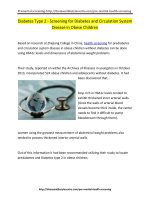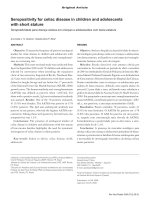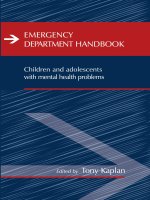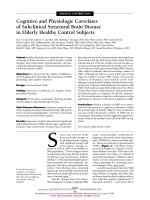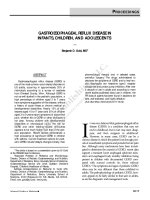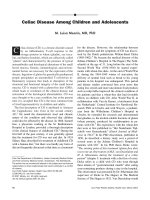GASTROESOPHAGEAL REFLUX DISEASE IN INFANTS, CHILDREN, AND ADOLESCENTS doc
Bạn đang xem bản rút gọn của tài liệu. Xem và tải ngay bản đầy đủ của tài liệu tại đây (296.4 KB, 6 trang )
Advanced Studies in Medicine ■ S117
ABSTRACT
Gastroesophageal reflux disease (GERD) is
one of the most common acid-related disorders in
US adults, occurring in approximately 20% of
individuals according to a survey of residents
from Olmsted County, Minn. Although GERD is
not as well studied in the pediatric population, a
high percentage of children aged 3 to 7 years
have symptoms suggestive of this disease, without
a history of acute illness or chronic medical or
developmental disabilities. Nearly 15% of ado-
lescents aged 10 to17 years and 25% of children
aged 3 to 9 years report symptoms of abdominal
pain; whether this is GERD or other etiologies is
not clear. Among children with developmental
disabilities or neurological injury, the risk for
GERD and other feeding-related difficulties
appears to be much higher than that of the gen-
eral population. Recent studies demonstrate a
high prevalence of significant GERD in children
with asthma. Current treatment options for pedi-
atric GERD include lifestyle changes initially, then
pharmacologic therapy and, in selected cases,
antireflux surgery. The drugs administered to
decrease the symptoms of GERD and to heal ero-
sive esophagitis are histamine type-2 receptor
antagonists and proton pump inhibitors. After over
a decade of use in adults and according to more
recent studies published about use in children, the
PPI class of agents has been found in studies to be
safe, well tolerated, and highly effective.
1
(Adv Stud Med. 2003;3(3A):S117-S122)
I
t was once believed that gastroesophageal reflux
disease (GERD) is a condition that may not
end in childhood, but in fact may start, disap-
pear, and then reappear in adulthood.
However, in many cases, GERD can be a
chronic disease in which the patient lives through peri-
ods of exacerbated symptoms and periods that are pain
free. Although many mechanisms have been investi-
gated to determine the cause(s) of GERD, recent data
support a transient lower esophageal sphincter relax-
ation and esophageal body motility inhibition being
present in children with documented GERD com-
pared with normal controls (ie, those without
GERD).
2
The symptoms and signs of pediatric GERD
often may be very different than those exhibited in
adults. The pathophysiology of pediatric GERD, how-
ever, appears to be fairly similar to that seen in adults,
as are the diagnostic and management tools.
PROCEEDINGS
GASTROESOPHAGEAL REFLUX DISEASE IN
INFANTS, CHILDREN, AND ADOLESCENTS
*
—
Benjamin D. Gold, MD
†
* This article is based on a presentation given by Dr Gold
at the PRI-MED East Conference.
†
Associate Professor of Pediatrics and Microbiology,
Director, Division of Pediatric Gastroenterology and Nutrition,
Department of Pediatrics, Emory University School of Medicine,
Gastroenterology Service Line Chief, Egleston Children’s
Hospital, Children’s Healthcare of Atlanta.
Address correspondence to: Benjamin D. Gold, MD,
Director, Division of Pediatric Gastroenterology and Nutrition,
Department of Pediatrics, Emory University School of
Medicine, 2040 Ridgewood Dr, NE, Atlanta, GA 30322.
E-mail: emory.edu.
S118 Vol. 3 (3A) ■ March 2003
PROCEEDINGS
PREVALENCE OF GERD IN US CHILDREN
More than 85% of premature infants have some
evidence of GERD, with 3% to 10% of these patients
having supraesophageal manifestations of the disease
including bradycardia and apnea. Many former pre-
mature infants will have GERD-induced exacerbation
of bronchopulmonary dysplasia; the neonatal equiva-
lent of adult chronic obstructive pulmonary disease
and the result of prolonged ventilator support required
by these prematurely born children shortly after birth.
In the past, it was commonly believed that GERD
completely resolved in infants by 3 months of age.
However, there is now evidence to suggest the con-
trary, because almost 100% of infants at the age of 3
months will have evidence of reflux. Whether true dis-
ease, in one form or another, exists deserves further
study. However, approximately 33% will seek medical
attention and the regurgitation symptoms in most
(>70%) of these children will resolve with minimal
intervention and no diagnostic evaluation. In addi-
tion, until recently, no long-term follow-up pediatric
studies existed. Retrospective studies demonstrate that
by 6 months of age, 20% of infants require further
evaluation because of reported symptoms of GERD.
In up to 40% of cases, pH monitoring reveals signifi-
cant acid exposure (pH <4.0) to the distal esophagus
for more than 5% of a 24-hour period (1.2 hours or
longer).
3-5
HOSPITALIZED CHILDREN
Overall, GERD is a significant problem in hospi-
talized children, with more males than females being
affected. Review of a large, national pediatric hospital
database showed that in 1997 less than 2% of children
hospitalized in the United States had Barrett’s esopha-
gus, a specific columnar lining that may be a precursor
to esophageal cancer, as 1 of the top 5 discharge diag-
noses. However, in 2000, the number of hospitalized
children with a discharge diagnosis of Barrett’s esoph-
agus increased to almost 4%. According to data from
the same large database, the Pediatric Health
Information Survey, a consortium of approximately 37
children’s hospitals across the US, in the year 2000
3.5% of all pediatric hospital discharges were related
to GERD as 1 of the top 3 discharge diagnoses, and
$750 million in annual costs were incurred that were
related primarily to the surgical management of chil-
dren with GERD. Specifically, there has been a nation-
al increase in the frequency of fundoplications
performed on children. In another study, the diagno-
sis of GERD in hospitalized infants increased 20-fold
in a single naval hospital from 1971 to 1995. It has not
been determined whether these growing numbers are
due to a rising prevalence of GERD, more awareness
of it and improved diagnostic testing, or both.
6,7
Hospitalized and nonhospitalized children with a
history of severe GERD symptoms suffer from a num-
ber of esophageal complications such as erosive
esophagitis, Barrett’s esophagus, and other esophageal-
related maladies. In some special populations, the
numbers of children with GERD are particularly high.
For example, among children with a neurologic injury
or impairment such as cerebral palsy, 30% to 70% of
children will eventually suffer from erosive esophagitis.
Other esophageal and supraesophageal complications
in severe pediatric GERD include esophageal stric-
tures, laryngitis, sinusitis, pharyngitis, apnea, brady-
cardia, seizures, and adenocarcinoma (primarily where
there is concomitant neurologic injury or congenital
abnormalities of esophagus). Approximately 27% of
hospitalized children with GERD show signs of respi-
ratory disease.
4,7,8
Not only are the relative numbers of pediatric
GERD cases increasing over the years, but the disease
also appears to become more clinically relevant and
change in character with advancing age. Nelson
reviewed the cases of more than 1700 children, track-
ing them from newborn to adolescence, and noted
that the presenting symptoms of reflux disease
changes from a more regurgitant component (eg,
vomiting) to one of a more pain-related type: a sig-
nificant increase in the evidence of heartburn or epi-
gastric pain as children age.
4
From ages 3 to 9 years,
1.8% of children show signs of heartburn; however,
from ages 18 to 21 years, 22% of young adults expe-
rience this symptom.
4
In addition, one fourth of
adults who have documented GERD will have had
some evidence of childhood symptoms.
5
SYMPTOMS AND MANIFESTATIONS OF GERD
The symptoms and manifestations of GERD in
children vary and can be very distinct from those in
adults (Table 1). In the pediatric population they
include regurgitation, persistent vomiting that causes a
failure to thrive, and signs of esophagitis. Caregivers
may report feeding difficulties such as the child refus-
ing to eat, arching and inconsolable crying, hemateme-
Advanced Studies in Medicine ■ S119
PROCEEDINGS
sis, and water-brash (spitting up). Other significant
physical manifestations of GERD that have been docu-
mented are anemia, weight loss, Sandifer’s syndrome
(which may cause head turning as a result of esophageal
inflammation), and stricture. Older children may report
heartburn, dysphagia, and/or odynophagia.
The supraesophageal manifestations of GERD in
children are similar to those found in adults. These
include chronic sore throat and cough, hoarseness,
wheezing and asthma, and specific to the infant popula-
tion, apnea and bradycardia. Dental erosions and halito-
sis may also be a result of chronic GERD in children.
Two particularly troublesome conditions that appear
to be related to GERD in children are apnea and dam-
age to the laryngo-pharyngeal and vocal cords, called
laryngopharyngeal reflux disease. It is still controversial
as to whether there is a true cause-and-effect relationship
between GERD and apnea. However, in some children
being evaluated for suspected GERD-induced
apnea/bradycardia a definite relationship has been
shown; when esophageal pH drops below 4.0, there is a
cessation in nasal airflow and chest wall movement. This
phenomenon is referred to as reflux-associated apnea.
9,10
Clearly, intervention trials are needed to determine
whether infants are experiencing reflux-associated apnea,
in which case treatment may reduce episodes or elimi-
nate them completely.
Another supraesophageal complication of GERD
observed among children is damage to the laryn-
gopharyngeal area and vocal cords. Specifically, vocal
cords may develop a granular exudative surface with
induration and irregular contact edges and posterior
rugae—all as a result of chronic reflux of gastric con-
tents. The inflammation and vocal cord damage
appears, in anecdotal cases, to completely resolve with
sufficient acid suppression. Prospective pediatric treat-
ment trials in this population are definitely needed.
D
IAGNOSTIC TESTING
In the diagnosis of pediatric GERD, the initial
workup—particularly in those children with regurgita-
tion predominant symptoms—should look for
anatomical abnormalities such as strictures, achalasia,
intestinal malrotation, or hiatal hernia. Although these
abnormalities are often detected via an upper gastroin-
testinal (GI) contrast study, if the clinician uses the
upper GI solely to diagnose GERD, many false-nega-
tives and -positives will occur. Upper GI endoscopy is
another useful test in the diagnosis of GERD. It is an
especially valuable tool because it enables physicians to
diagnose and rule out reflux esophagitis, Barrett’s dis-
ease, and other types of inflammatory or infectious
forms of esophagitis such as Crohn’s disease, herpes
simplex virus, or candida.
Finally, the 24-hour intraesophageal pH study, par-
ticularly if the child’s caregiver supplies a detailed diary
of the child’s symptoms to accompany the study, is a reli-
able test to determine the presence of nocturnal silent
reflux, the rapidity of esophageal acid clearance, and the
adequacy of acid suppression. This procedure, in which
a catheter is passed through the nose, into the back of the
throat, and down towards the esophagus, is not deemed
to be necessary if the patient is vomiting.
11
MANAGEMENT OPTIONS
The primary goals in managing GERD are to elim-
inate symptoms, heal esophagitis, prevent or manage
complications, and maintain remission (Figure). Since
GERD may be a lifelong disease, this condition and its
long-term sequelae, which often appear in adulthood,
may be most effectively handled if it is diagnosed and
treated during childhood.
Table 1. Symptoms and Manifestations of GERD
in Children
GERD = gastroesophageal reflux disease; GER = gastroesophageal reflux.
Regurgitation (GER vs GERD; ie, physiologic vs pathologic?)
– Vomiting (ie, “fat, happy spitter”) – most common
Persistent vomiting
– Failure to thrive
Esophagitis
– Feeding refusal, difficulties, resistance
– Arching, crying (inconsolably) during initiation of feeds
– Hematemesis
– Water-brash (“spit-up” burps)
– Anemia, weight loss
– Sandifer’s syndrome (child presents with ‘head turning’ as a result
of esophageal inflammation)
– Heartburn (“heartburn” symptoms reported in older child,
adolescent)
– Dysphagia /odynophagia
– Stricture
NONSURGICAL MANAGEMENT OF
MILD TO MODERATE GERD SYMPTOMS
Educating the caregivers of pediatric patients is
vital in managing mild GERD symptoms. Specifically,
a change in the patient’s diet and lifestyle is often nec-
essary. In infants, thickened feeds and sitting the child
upright for a period of 45 minutes to 1 hour after feeds
often lessens the number of regurgitation episodes. In
addition, elevation of the crib or mattress at the head
of the bed often eases nighttime symptoms. Obesity
can be a contributing factor to GERD, so weight man-
agement in older children is encouraged.
11
If pharmacotherapy is necessary, antacids are some-
times helpful for symptom relief. Anticholinergics may
be effective, but they are usually not recommended
due to the high incidence of side effects.
11
On the
other hand, histamine type-2 receptor antagonists
(H2RAs) and proton pump inhibitors (PPIs) are rec-
ommended and have been approved for use in the
pediatric population by the US Food and Drug
Administration (FDA). Safety and dosing data have
been well established for medications such as raniti-
dine, famotidine, lansoprazole, and omeprazole. The
motility component of GERD is still not yet adequate-
ly addressed with currently available pharmacologic
agents. Prokinetic drugs such as metoclopramide are also
sometimes employed in the treatment of GERD.
However, safety issues are of concern with the use of
available prokinetic agents, particularly when adminis-
tered doses are high enough to achieve the desired anti-
regurgitant effect. Cisapride has been withdrawn from
use by the FDA and metoclopramide has the potential
for irreversible central nervous system complications.
Data indicate that the PPI, lansoprazole (15 to 30
mg qd), administered to children aged 1 to 11 years
with erosive esophagitis resulted in 78% of the subjects
being healed by week 8 of treatment and 100% of sub-
jects having their erosive esophagitis healed by week
12.
12
Data regarding the 6-month efficacy of another
PPI, omeprazole, in children also demonstrated a sim-
ilar spectrum of symptom relief and esophagitis heal-
ing. Hassall et al conducted an open multicenter study
of 57 children aged 1 to 16 years with a diagnosis of
erosive esophagitis.
13
The children were administered
escalating doses of omeprazole in order to achieve an
optimal dose to maintain the duration of esophageal
acid reflux <6% in a 24-hour pH study. In these chil-
dren, there was marked reduction in symptoms,
including heartburn, dysphagia, irritability, and
coughing, both at an interim visit 5 to 14 days into the
study and at the healing visit on day 120.
13
Although no head-to-head pediatric comparative
studies have been performed, data from H2RA and
PPI treatment trials in similar patient populations
demonstrate a superior efficacy of PPIs over H2RAs in
the treatment of pediatric GERD. For example, recent
studies demonstrated that PPIs heal severe erosive
esophagitis in up to 100% of the children in which
they were administered.
12
PPIs were shown to be effec-
tive even in patients whose GERD was refractory to
other medications and who have failed surgery.
12,13
For
short-term healing, PPIs in children have been shown
to be safe and effective. However, PPI administration
in the pediatric population has been shown to require
wider dosing ranges for treatment efficacy than is rec-
ommended for adults. Indeed, studies demonstrate
that PPI doses used in the pediatric population are
sometimes higher than those administered to adults
due to the fact that children, in part, metabolize these
medications faster than their older counterparts.
13-16
There are a variety of formulations of PPIs available
for use in pediatric GERD patients. Both lansoprazole
and omeprazole have been shown to be equally as
effective in liquid suspension, and there is a lansopra-
zole packet for suspension that is strawberry flavored.
Furthermore, PPI capsules can be opened and sprin-
kled into food (eg, applesauce or ice cream) while
S120 Vol. 3 (3A) ■ March 2003
PROCEEDINGS
Figure.Treatment of Gastroesophageal Reflux
Disease (GERD)
Advanced Studies in Medicine ■ S121
maintaining good bioavailability and similar efficacy.
In addition, there are other PPI formulations under
development including fast-dissolving tablets and
intravenous preparations.
S
URGERY
Antireflux surgery is another option for the treat-
ment of childhood GERD, particularly in those
patients with a significant motility or regurgitant
component to their disease. Fundoplication is the
third most common procedure performed on children
today. Between 1995 and 1999, approximately 25%
to 27% of hospitalized children with the primary dis-
charge diagnosis of GERD underwent fundoplica-
tion.
7
However, caution and careful case selection
should be used as significant morbidity and mortality
can be associated with surgery, particularly in children
with neurologic injury (eg, the cerebral palsy popula-
tion). Thus, antireflux surgery is not recommended
for all pediatric patients. The decision to move for-
ward with surgical intervention should be made care-
fully on a case-by-case basis. Recent pediatric data
support previously published adult studies demon-
strating that those patients with GERD who respond
to medical therapy have better outcomes with antire-
flux surgery. To date, no comparative outcome or cost-
effectiveness studies with PPI versus surgery have been
performed in the pediatric population.
In summary, mild spitting and irritability often
characterize uncomplicated GERD in infants. GERD
is most frequently diagnosed by history and physical
exam, and best approached by providing parental
guidance and reassurance, slight lifestyle changes, and
possible empiric treatment with prokinetic or antise-
cretory agents (H2RA/PPI). Refractory cases of infant
GERD should be referred to a specialist for diagnos-
tic testing (ie, upper GI) to rule out anatomic abnor-
malities such as hiatal hernia or achalasia, and pH
metry with an accompanying diary to demonstrate
reflux episode association with symptoms (Table 2).
Complicated GERD in infants often presents with
poor weight gain, dysphagia, apnea, respiratory symp-
toms, irritability, and hematemesis. Diagnostic
options include endoscopy with biopsies and 24-hour
pH metry. Recommended therapies include acid sup-
pression via H2RA/PPI, prokinetic medications,
change in formula, and increased caloric density,
although infants with complicated GERD often
require the expertise of a specialist.
PROCEEDINGS
Table 2. GERin Infants:Management Approach
GER = gastroesophageal reflux; GI= gastrointestinal; H2RA = histamine type-2 recep-
tor antagonist; PPI = proton pump inhibitor.
Table 3. GERin Older Children:Management Approach
GER = gastroesophageal reflux; GI= gastrointestinal; H2RA = histamine type-2 recep-
tor antagonist; PPI = proton pump inhibitor.
Uncomplicated GER
“Happy spitter”/Mildly colicky
•
Parental guidance/reassurance
•
Lifestyle changes
(elemental or thickened formula)
•
Worsening symptoms or
persistence >24 mo
•
Upper GI contrast study
•
Empiric treatment with prokinetic
or antisecretory (H2RA / PPI)
•
Consider referral to specialist
Complicated GER
•
Poor weight gain, dysphagia,
apnea, respiratory symptoms,
irritability, hematemesis
•
Referral to specialist
•
Diagnostic options:
Endoscopy, pH probe
•
Rx options: Acid suppression,
(H2RA/PPI), prokinetic, formula
change, increase caloric density
Heartburn
•
Lifestyle changes
•
Trial PPI or H2RA for
2–4 weeks
•
Referral to specialist if
symptoms persist or recur
•
Endoscopy and possible
long-term treatment
Complicated GER
•
Odynophagia, dysphagia,
hematemesis, food lodged
•
Referral to specialist
•
Upper GI and endoscopy
•
Treatment with PPI for
erosive esophagitis
•
Repeat endoscopy for
erosive esophagitis
In older children with complicated GERD, symp-
toms can range from odynophagia to dysphagia to
hematemesis. To diagnose complicated GERD, physi-
cians commonly perform 24-hour pH metry and
endoscopy with biopsies. (NOTE: A complete algorithm
scheme for children of different ages with GERD is pro-
vided in the recently published North American Society
for Pediatric Gastroenterology and Nutrition clinical
practice guidelines for GERD.)
11
The management
approach taken in older children with GERD is slightly
different than in younger children and infants. Often,
older children with mild GERD first present with heart-
burn as a key symptom. As with infants, lifestyle changes
(particularly weight management) are often recom-
mended. Administration of a PPI or H2RA for a period
of 2 to 4 weeks is suggested. If systems persist, the older
child with GERD should be referred to a specialist.
Treatment with PPIs is recommended for all patients
with erosive esophagitis diagnosed by the pediatric gas-
troenterologist via upper endoscopy (Table 3).
C
ONCLUSION
In conclusion, pediatric GERD is a more common
problem than previously recognized, and its presenta-
tion (ie, signs and symptoms) in the pediatric popula-
tion may differ from GERD in adults. Early diagnosis
and treatment may prevent lifelong GERD complica-
tions. Effective therapies, such as PPIs, are safe, avail-
able, and should be employed in the management of
this common and chronic disease that causes signifi-
cant morbidity and human suffering.
REFERENCES
1. Managing Acid-Related Disorders Through the Ages of Man
[abstract book]. PRI-MED East Conference; Nov 7, 2002;
Boston, Mass.
2. Kawahara H, Dent J, Davidson G. Mechanisms responsible
for gastroesophageal reflux in children. Gastroenterology.
1997;113:399-408.
3. Gibbons TE, Stockwell J, Kreh RP, McRae S, Gold BD.
Population based epidemiological survey of gastroe-
sophageal reflux disease in hospitalized US children.
Gastroenterology. 2001;120(5):154.
4. Nelson SP, Chen EH, Syniar GM, Christoffel KK.
Prevalence of symptoms of gastroesophageal reflux during
childhood. Arch Pediatr Adolesc Med. 2000;154:2.
5. Waring JP, Feiler MJ, Hunter JG, Smith CD, Gold BD.
Childhood gastroesophageal reflux symptoms in adult
patients. J Pediatr Gastroenterol Nutr. 2002;35:334-338.
6. Callahan CW. The diagnosis of gastroesophageal reflux in
hospitalized infants: 1971-1995. J Am Osteopath Assoc.
1998;98(1):32-34.
7. Gibbons TE, Stockwell J, Kreh RP, et al. Population-based epi-
demiologic survey of gastroesophageal reflux disease in hospi-
talized US children. Gastroenterology. 2001;120:154.
8. Hassall E. Co-morbidities in childhood Barrett’s esophagus.
J Pediatr Gastroenterol Nutr. 1997;25:255-260.
9. Herbst JJ, Minton SD, Book LS. Gastroesophageal reflux
causing respiratory distress and apnea in newborn infants.
J Pediatr. 1979;95:763-768.
10. Wenzl TG, Schenke S, Peschgens T, Silny J, Heimann G,
Skopnik H. Association of apnea and nonacid gastroe-
sophageal reflux in infants: investigations with the intralumi-
nal impedance technique. Pediatr Pulmonol. 2001;31:
144-149.
11. Rudolph J, Mazur LJ, Liptak GS, et al. Guidelines for evalua-
tion and treatment of gastroesophageal reflux in infants and
children: recommendations of the North American Society
for Pediatric Gastroenterology and Nutrition. J Pediatr
Gastroenterol Nutr. 2001;32(suppl 2):S1-S31.
12. Tolia V, Ferry G, Gunasankeran T, Huang B, Keith R, Book
L. Efficacy of lansoprazole in the treatment of gastroe-
sophageal reflux disease in children. J Pediatr Gastroenterol
Nutr. 2002;35(suppl 4):S308-S318.
13. Hassall E, Israel D, Shepherd R, et al. Omeprazole for
treatment of chronic erosive esophagitis in children: A multi-
center study of efficacy, safety, tolerability and dose require-
ments. J Pediatr. 2000;137:800-807
14. Gunasekaran TS, Hassall E. Efficacy and safety of omepra-
zole for severe gastroesophageal reflux in children.
J Pediatr. 1993;123:148-154.
15. Hassall E and the International Pediatric Omeprazole
Study Group. Omeprazole for maintenance therapy of
erosive esophagitis in children. Gastroenterology. 2000;
118:A3610.
16. Andersson T, Hassall E, Lundborg P, et al. Pharmacokinetics
of orally administered omeprazole in children. Am J
Gastroenterol. 2000;95:3101-3106.
S122 Vol. 3 (3A) ■ March 2003
PROCEEDINGS
